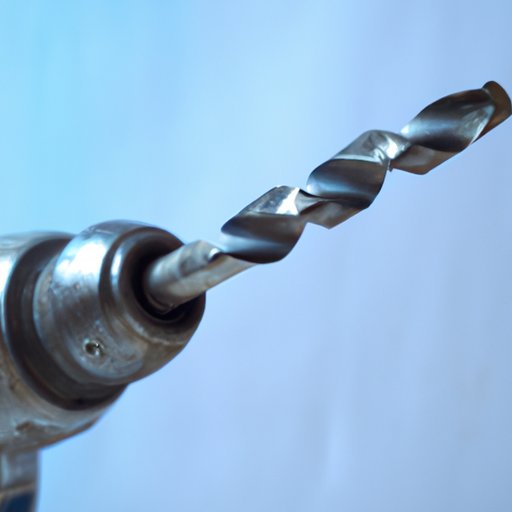Introduction
A hammer drill is a versatile tool that is used to bore holes in materials such as wood, concrete, brick, and stone. It works by combining rotation with an up-and-down hammering action to break up the material and create a hole. The purpose of a hammer drill is to provide a quick and efficient way to bore holes into hard materials.
A Step-by-Step Guide to Using a Hammer Drill
Before using a hammer drill, it is important to take safety precautions to ensure the job is done safely and correctly. These precautions include wearing protective eyewear, ear protection, and gloves. Additionally, make sure the area around the work surface is cleared of any debris or obstructions.
Once the safety precautions are taken care of, the next step is to prepare the material for drilling. This may involve measuring and marking the spot where the hole will be drilled. The material should then be clamped down securely to prevent it from shifting during drilling.
The third step is to set up the drill and bit. Make sure the bit is properly inserted into the chuck of the hammer drill and tightened securely. If necessary, adjust the speed setting of the drill to ensure the bit is rotating at the proper speed.
The fourth step is to operate the drill. To do this, press the trigger and gently apply pressure to the drill bit. As the bit rotates, it will begin to break up the material and create a hole. Keep the drill bit parallel to the surface to ensure a clean and even hole.
The final step is to finish the job. Once the hole is created, remove the bit from the hammer drill and dispose of the debris. It is also important to inspect the hole to make sure it meets your expectations.
Exploring the Science Behind Hammer Drills
To better understand how a hammer drill works, it is important to explore the mechanics behind it. Hammer drills are powered by a motor that causes the drill bit to rotate. As the bit rotates, a piston inside the drill body moves up and down, creating a hammering action. This action breaks up the material and creates a hole.
When comparing hammer drills to traditional drills, one of the main differences is the hammer action. Traditional drills are only capable of spinning the bit, while hammer drills combine the spinning motion with the hammering action. This combination allows for more efficient drilling, especially in hard materials such as concrete.

How Hammer Drills Differ from Traditional Drills
Hammer drills differ from traditional drills in several ways. First, they have higher speeds and greater torque than traditional drills. This allows them to work more quickly and efficiently. Additionally, hammer drills are typically larger and heavier than traditional drills, making them better suited for heavy-duty jobs.
Another difference between hammer drills and traditional drills is the type of bit used. Hammer drills require special bits that are designed to withstand the hammering action. These bits come in a variety of sizes and shapes, allowing you to choose the right one for the job.

Understanding the Benefits of Hammer Drills
Using a hammer drill offers several benefits. One of the most obvious is increased efficiency. Because of their hammering action, hammer drills can quickly and easily bore through hard materials. This makes them ideal for jobs that require precise and accurate holes.
Hammer drills are also very versatile. They can be used for a variety of tasks, such as drilling into masonry, concrete, and even metal. Additionally, they are more durable than traditional drills, meaning they can handle tougher jobs without breaking down.

Tips and Tricks for Best Results When Using a Hammer Drill
When using a hammer drill, there are several tips and tricks that can help ensure the best results. First, make sure to choose the right bit for the job. This will ensure the bit is able to withstand the hammering action and won’t wear out quickly.
It is also important to maintain the right angle when drilling. This will help ensure the hole is straight and even. Additionally, it is important to control the speed and pressure of the drill. Applying too much pressure can cause the bit to slip, resulting in an uneven or crooked hole.
Conclusion
A hammer drill is a powerful and versatile tool that can be used for a variety of tasks. Its combination of rotation and hammering action makes it ideal for drilling into hard materials such as masonry and concrete. Additionally, its increased speed and torque allow for faster and more efficient drilling.
When using a hammer drill, it is important to take proper safety precautions and use the right bit for the job. Additionally, controlling the speed and pressure of the drill can help ensure the best results. With these tips and tricks, you can get the most out of your hammer drill and make the job easier.
Summary
A hammer drill is a powerful tool that is used to bore holes in hard materials such as masonry, concrete, and stone. It combines rotation with an up-and-down hammering action to break up the material and create a hole. Hammer drills offer several benefits, including increased efficiency, versatility, and durability. When using a hammer drill, it is important to take safety precautions, choose the right bit, and control the speed and pressure for best results.
(Note: Is this article not meeting your expectations? Do you have knowledge or insights to share? Unlock new opportunities and expand your reach by joining our authors team. Click Registration to join us and share your expertise with our readers.)
